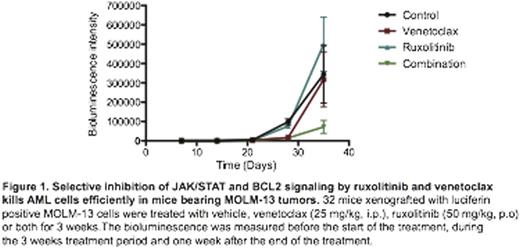Abstract
Several promising new, targeted agents are being developed for the treatment of AML. The BH3 mimetic venetoclax (ABT-199) is a specific inhibitor of BCL2, with results from a phase 2 study showing transient activity of venetoclax in relapsed/refractory AML (Konopleva et al, 2014). The bone marrow (BM) microenvironment is known to protect AML cells from drug therapy and we showed earlier that conditioned medium (CM) from BM stromal cells applied to AML patient cells conferred resistance to venetoclax, which could be reversed by the addition of the JAK1/2 inhibitor ruxolitinib (Karjalainen et al, 2015). Here, we investigated the mechanisms mediating the BM stromal cell induced resistance to venetoclax and its reversal by ruxolitinib.
To identify the soluble factor(s) contributing to stroma-induced protection of BCL2 inhibition, we analyzed the cytokine content of 1) CM from the human BM stromal cell line HS-5, 2) CM from BM mesenchymal stromal cells (MSCs) isolated from AML patients, 3) supernatants from BM aspirates collected from AML patients, and 4) supernatants from BM aspirates collected from healthy donors. Although expression levels varied, the cytokines detected were similar among the different samples. In HS-5 CM, IL-6, IL-8 and MIP-3α were among the most abundant cytokines. In addition, gene expression analysis showed the receptors for these cytokines were expressed in AML patient samples. IL-6, IL-8 and MIP-3α were added individually to mononuclear cells collected from AML patients, which were then treated with venetoclax. However, none of the cytokines alone could mimic the reduced sensitivity to venetoclax conferred by the HS-5 CM suggesting that stromal cell induced cytoprotection is likely multi-factorial.
Next we tested the effect of AML-derived BM MSCs on the ex vivo response of AML patient samples (n=8) to ruxolitinib or venetoclax alone or in combination in a co-culture setting. Apoptosis assays showed negligible effects of ruxolitinib at a concentration of 300 nM, while venetoclax at a dose of 100 nM induced reduction in the percentage of CD34+ AML cells. Co-treatment with venetoclax and ruxolitinib demonstrated synergistic effects in 6 out of 8 samples and significantly reduced the number of CD34+ AML cells. Mechanistic studies showed that ruxolitinib treatment inhibited the BM stromal medium-induced expression of BCL-XL mRNA on AML cells and the drugs in combination down-regulated BCL2, MCL1 and BCL-XL protein expression, which was in correlation with sensitivity to the drugs.
To further evaluate the ability of the venetoclax and ruxolitinib combination to eradicate leukemic cells in vivo we used an orthotopic xenograft model of AML. NSG mice were injected with genetically engineered MOLM-13luc cells and after engraftment treated with venetoclax (25 mg/kg, i.p.), ruxolitinib (50 mg/kg BID, p.o) or both and imaged once per week for 4 weeks. At the end of the treatment period bioluminescent imaging showed significantly reduced leukemia burden in the ruxolitinib and venetoclax co-treated mice compared to controls demonstrating superior anti-tumor efficacy than either agent alone (Figure 1).
In summary, our data demonstrate that the combined blockade of JAK/STAT and BCL2 pathways with ruxolitinib and ventoclax is synergistic in ex vivo co-culture models and in vivo in an AML mouse model. The addition of ruxolitinib was able to overcome intrinsic resistance to venetoclax by reducing expression of MCL1, a known escape mechanism of BCL2 inhibition. These results support further clinical investigation of this combination, particularly for relapsed/refractory AML.
Porkka:Novartis: Honoraria, Research Funding; Pfizer: Honoraria, Research Funding; Bristol-Myers Squibb: Honoraria, Research Funding. Wennerberg:Pfizer: Research Funding. Gjertsen:BerGenBio AS: Equity Ownership, Membership on an entity's Board of Directors or advisory committees; Boehringer Ingelheim: Membership on an entity's Board of Directors or advisory committees; Kinn Therapeutics AS: Equity Ownership. Heckman:Celgene: Research Funding; Pfizer: Research Funding.
Author notes
Asterisk with author names denotes non-ASH members.


This feature is available to Subscribers Only
Sign In or Create an Account Close Modal